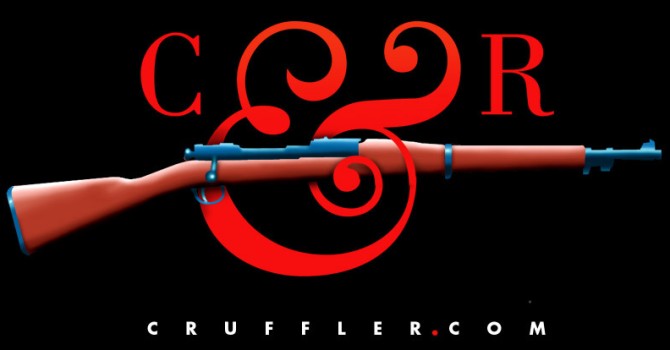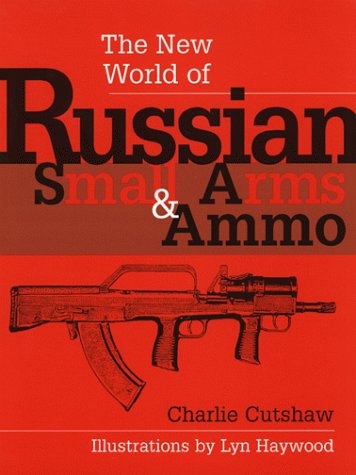
|
|
|
|
|
|
 |
| The
New World of Russian Small Arms & Ammo
by Charlie Cutshaw Paladin Press, 1998, hardcover 152 pages ISBN: 0-87364-993-1 $42.95
|
|
The book is a survey of Russian small arms developments from the late Soviet era through the late 1990's, with a particular emphasis on developments taking place in the post Soviet era. As such it should prove utterly fascinating to all students of firearms history, development and technology. While most are familiar with the standard Soviet fare such as the AK-47/AKM/AK-74, the Pistolet Makarova, the Tokarev pistol and the Stechkin machine pistol, they are equally as unfamiliar with the developments in Russian small arms over the last thirty years. Unlike small arms development in the west, which was largely evolutionary and concentrated on a handful of established designs, small arms development in the Soviet Union and Russia followed many paths, some evolutionary, many revolutionary and some so far from conventional thought as to be best described as incarnations of flights of fancy. Prior to the publication of The New World of Russian Small Arms & Ammo, there was no readily available source of information as to these fascinating developments.
Organization is as one would expect, with the book being broken into chapters covering rifles, pistols and revolvers, submachine guns, tactical shotguns, grenade launchers, and ammunition. Each chapter is subdivided into discrete sections dealing with individual firearms or weapon systems. This format is simple and straightforward and facilitates the book's use as a reference, but it is not without attendant risk. There are essentially three paths a volume so organized can take, each defined by the nature and quality of the supporting text. At its most basic, the book can be a collection of performance specifications and statistics. That there is a call for this type of work is evidenced by the tremendous success of Jane's yearbooks. However, it makes for a somewhat dry book that often leaves the reader unenlightened as to the history and development of the arm being described. The second form of this type of book is a series of subjective and anecdotal accounts told solely from the author's perspective. Unless the author is a gifted author whose command of language makes anything springing from his pen a joy to read, this type of book rapidly degenerates into a tedious exposition of the author's preconceptions and prejudices. The third, and most difficult to attain, form is what we'll refer to as "journalistic." A book written in this fashion combines objective fact with clear and objective prose that provides the who, what, when, where and why of a newspaper article. The reader comes away with a clear understanding not only of the arm's characteristics and capabilities, but of how and why it came into being. The author's challenge is to keep subjective opinion and editorializing to a minimum while conveying as much information as possible to a readership that is probably not well versed in the subject matter.
With few exceptions, Cutshaw meets this challenge in an able and workmanlike manner. A pair of examples provide ample illustration:
Discussing the OTs-14 Groza (Thunderstorm) assault rifle:
The OTs-14 began life as an idea of Valery Telesh, who is better know his design of the GP-25 and GP-30 underbarrel grenade launchers. Telesh noticed the effectiveness of the U.S. M203 but felt that the weapon was hampered by many drawbacks for combat use, not the least of which was that the rifle grenade launcher combination was overly heavy and cumbersome. Telesh believed that the addition of the M203 destroyed the balance of the weapon and made it too hard to use. He therefore set out to design an integrated system that would incorporate all the desirable features of a close combat arm into one manageable package, using the basic Kalashnikov rifle as a starting point. Telesh and a gentleman named Yuri V. Lebedev began work on the project in December 1992; prototypes were ready in less than a year, and the OTs-14 was ready for production early in 1994 - a remarkable record for development of a small arms system such as the OTs-14.Discussing the RM/RMB-93/94/96 Tactical Shotgun:The original weapon was conceived as being able to use any one of four cartridges: the 5.45x39mm, the 5.56x45mm, the 7.62x39mm , or the 9x39mm. The latter cartridge is used in a number of Russian special weapons and is fully described in the ammunition chapter of this book.
The RM-93 series is very unusual in that the magazine is above the barrel of the gun, and the entire barrel assembly is pumped forward to cycle the action. The notion of pumping forward seems foreign (no pun intended) , but in practice it is not. The has fired the very similar South African Neostad tactical shotgun extensively, and pumping forward to cycle the action takes virtually no getting used to whatsoever. The RM-96 that I handled in Las Vegas in January 1998 was very smooth in operation and fed dummy rounds flawlessly. This does not, of course, mean that the gun will function similarly in the field, but it does give an indication. Shells are loaded into the RM-93 magazine through a loading door in the top of the receiver. The folding stock must be extended to load the gun; this is a disadvantage if the gun is being used tactically with the stock folded. The stock can, however, be removed. To load, the magazine cover is opened to expose the loading port. Part of the feed mechanism is housed in the magazine cover. When the RM-93 is loaded, the cover closed, and the barrel assembly pumped forward, a guide presses the next shell down into position against the breech face as the spent shell is ejected. Like the South African Neostad, the RM-93 has no bolt per se. Once the shell is in position against the breech face, the barrel assembly is pulled to the rear and telescoped over the shell. (This virtually eliminates extraction and ejection problems.) The gun is then ready to fire. When the barrel assembly is pumped forward, the spent shell is held in place against the breech face and ejected straight down as the following shell comes into position for chambering. The trigger of the RM-93 is double action only (i.e., it must go through a long, relatively heavy pull, which cocks and releases the hammer each time the gun is fired).If the text is the book's strong point, the only "failing" can be said to be the illustrations. While veteran gun illustrator Lyn Haywood's work is top notch, and his drawings are no doubt excellent renditions of the subject firearms, they are no substitute for large numbers of clear photographs that illustrate many of the points that are left to the reader's imagination by the text. As failings go, this is a minor one, and one that detracts very little from the book's intrinsic value. Indeed, Haywood's skill goes very far toward making up for any perceived deficiencies.
CONCLUSION
The New World of Russian Small Arms & Ammo
is well written, and capably illustrated. It covers a fascinating
subject matter on which there is far too little information available in
the West, and does so in a manner that makes the information accessible
to both the veteran and the neophyte. Indeed, those aspiring to write
similar surveys would do well to emulate the style and meter of The
New World of Russian Small Arms & Ammo, and to make it a template
for their efforts. No student of firearms history should be without
a copy of this book. Paladin Press has a lot to be proud of with
this book.![]()
The New World of Russian Small Arms & Ammo is available from Amazon.com. Click on the image to order.:
 |